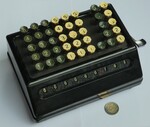
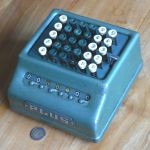
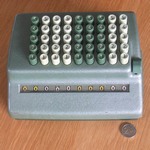
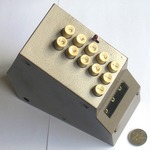
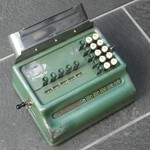
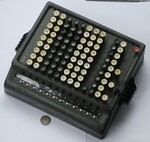
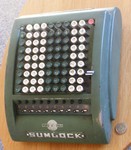
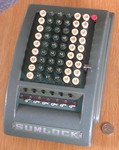
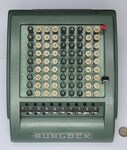
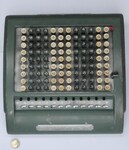
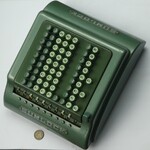
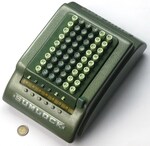
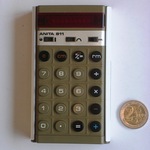
Introduction
Models
My Plus Adders
Model S/A5418
Video
Model 506/C/45953/L
Model 509/C/824523
Unknown industrial model
Bell Punch Analyser
Video
My Sumlocks
Model LC/913/SF/1024
Model 909/D/41440
Model 906/C/103629
Model 909/C/106268
Model 912/C/103412
Model 909/F/111304
Model 906/C/116410
Videos
My Anita 811
Books, Manuals, Tables
Sales Material
Paraphernalia
Advertisements
Patents
Links
Bell Punch was a British company that originally made machines for printing, punching, and dispensing tickets for public transport. In about 1936 they began selling mechanical calculators, modelled on the Comptometer, but utilizing a different and more compact mechanism. In 1940 a daughter company, the London Computator Corporation, was set up to handle the calculator business. This was renamed Sumlock Limited in 1950, after the calculator model name they had been using. In 1961 they bought the British parts of the Comptometer Corporation (what remained of Felt & Tarrant) and became Sumlock Comptometer Ltd. This also allowed them to officially call their calculators Comptometers (and Comptographs) from then on. They made the first fully electronic calculator in 1961. In 1973 this calculator company was bought by Rockwell, but was shut down a few years later in 1976.
In 1933 Petters Limited, a company known for making internal combustion engines, began making a compact calculator called the Petometer. It was designed by Guy Bazeley Petter, and was a simplified version of a Comptometer. It had a bakelite case, only had 5 rows of keys and no error detection. For most simple calculations, a comptometer operator would only use the bottom five rows of keys anyway, so it made sense to have a cheaper machine that dispensed with those unused keys. Such a simplified machine was very good for additions, but other operations were very much harder.
In 1936 Bell Punch bought the patents and manufacturing rights from Petters. At first they were probably still made by Petters, and just rebranded and sold by Bell Punch as the Plus Adder. The mechanism and case was then redesigned, and this improved version was made from about 1939 by Bell Punch themselves, and through various futher design changes production continued until at least the late 1960s.
The Sumlock model is a further development of the Plus model, and features a full 9-row keyboard, and has an error detection mechanism superficially similar to that of the Comptometer. When a button is not pressed down fully before it is released, then it will not come back up all the way, and all the other keys will be locked (including the other keys in the same column, which the comptometer does not do). After then fully pressing down the key where the error occured, press the red button to unlock the keyboard.
The Sumlock model first appeared in 1940, and remained in production until at least the late 1960s. Its styling changed, and it was rebranded the Sumlock Figureflow, and later the Sumlock Comptometer, and the 993M. In 1953 an electrically driven version was made that also had a second totalizer register, and this was called the Sumlock Duolectric, or 993S (S for storage). Finally in 1959 there was an electrically driven version with a third register that could do multiplications automatically, and which was called the Sumlomatic, Comptomatic, or 993C.
Fixed to the bottom of most Bell Punch mechanical calculators is a label listing various patents, as well as the model number and serial number. The model number consists of 3 digits followed by one or more letters. The first digit is the number of rows that the keyboard has, and the next two digits the number of columns it has, which is always 6, 9 or 12. So the Plus Adder has the number 506, 509 or 512, while a Sumlock has the number 906, 909 or 912. Note that the early Petometer-style Plus Adders do not have such a 3-digit model number.
The letter or letters in the model number denote the type of keyboard that the model has. The most common ones are the following:
| C or D | This designates a normal decimal keyboard, where every numeral wheel counts from 0 to 9. Supposedly the letter C means the keyboard is arranged for decimal currency, so the colouring of the key-columns ends with a group of two columns for the cents (i.e. the grouping is 1-3-2, 1-3-3-2, or 1-3-3-3-2), whereas the letter D means the keyboard is arranged for normal decimal calculations with key-column colouring which is in groups of 3 throughout (i.e. 3-3, 3-3-3, or 3-3-3-3). As many machines seem to have column colouring that contradicts this C/D distinction, it is unclear whether they have had their keys rearranged or whether no such distinction was made. |
|---|---|
| S | An S denotes a keyboard for Sterling currency. The right-most column will have 5 or 9 keys, though the numeral wheel in the register counts from 0 to 11 before carrying, to represent pennies. The second column is normal, but the third has only a 1 key and its wheel only counts from 0 to 1. These two columns together are for Shillings and count from 0 to 19. The rest of the columns are normal and coloured in groups of three. |
| F | An F keyboard has a column for Farthings, which has 3 keys and a numeral wheel that counts from 0 to 3 (or 0, 1/4, 1/2, 3/4). The next three columns are the same as the S type above for pence and sterling. |
| T | A T keyboard is for calculating times. The last two digits represent minutes, so only range from 00 to 59. This means that the last column is a normal decimal one, while the next column has 5 keys and a numeral wheel that only counts from 0 to 5. |
| Y | A Y keyboard is for calculating imperial weights. The final two digits of the register represent pounds - the last digit runs from 0 to 13, and will have a column of 5 or 9 keys, the next numeral wheel has only two values, 0 and 14, and it will usually have only one key in its column marked 14. 28 Pounds make a Quarter, so the next column represents Quarters. It has 3 keys and a numeral wheel that runs from 0 to 3. 4 Quarters make a Hundredweight (cwt.), and these are represented in the next two columns. They run from 0 to 19, so there is a normal decimal column and a column with one key and a numeral wheel that runs from 0 to 1. 10 Hundredweights make a Ton, and the remaining decimal columns count these. In some versions of this keyboard, the second pounds column has five keys marked 14, 28, 42, 56, 70. This makes it easier to add a number of stones (14 pounds) to the total, and pressing the higher numbers will always result in one, two or even three carries to the Quarters columns. |
| Z | A Z keyboard is also for calculating imperial weights. Its last column represents ounces, and runs from 0 to 15. The remaining columns are the same as the Y keyboard above. |
Any of these model letters can be preceded by the letters CP, which means that it has been fitted with the Certopost verification system. This is similar to Casting out nines, except that it is done modulo 13 instead of modulo 9. All the numbers on the register display a smaller red number underneath it. After any calculation, the red numbers on the calculation result are entered into the Certopost column, an extra key column on the far left of the machine. A simplified version of that calculation is done in the three highest columns of the machine, and the red numbers from its result also entered into the Certopost column. If both calculations were done correctly, the wheel in the Certopost column will show a *. If either calculation was incorrect, it will likely show a number instead.
The later versions of the Sumlock and the electrically driven models have various other letters in the model number, but still include the letter that denotes the type of keyboard. It seems however that at some point in the 1960s the only Sumlock models still being produced had Sterling currency keyboards, at which point they were renamed model 993, presumably standing for 9 rows, 9 Sterling columns, 3 columns for shillings and pence. This was followed by an M for the manual calculator (i.e. key-driven), E for the electrically driven standard model, S for the Duomatic model with the second storage register, and C for the Comptomatic model that could perform automatic multiplication.
In 1961 Bell Punch, or rather Sumlock Comptometer Ltd., made the first fully electronic calculator, the Anita Mk VII. It had a Comptometer/Sumlock style keyboard, i.e. a column of keys for each digit in the register, and pressing a key immediately adds to that digit. The Anita used Nixie tubes to display the register, and vacuum tubes and Dekatrons in the calculator circuits. The models Mk 8 to Mk 10 were very similar - the latter was made in 1965 and had a Sterling keyboard with key columns for shillings and pence. After that, transistors and integrated circuits started being used, and the keyboard changed to a more familiar 10-key design. In 1966 the electronic calculator split off in a separate company with the name Sumlock Anita Electronics, though the Anita machines continued to be sold under the Sumlock Comptometer Ltd. brand.
They made their first hand-held pocket calculator in 1972, the Anita 811. It was not the first in the world, as pocket calculators had first appeared in Japan in 1970. The boom in cheap electronics meant however that Sumlock Anita Electronics was bought in 1973 by Rockwell, and dissolved in 1976.
This early Plus adder is essentially identical to the Petometer by Petters Ltd., designed by Guy Bazeley Petter. It is quite possible that it was actually still made by Petters and just rebranded by Bell Punch. It is a model S, i.e. for Sterling currency equivalent to the later model 509S, and has serial number A5418. It was made somewhere between 1936 and 1940, between the time that Bell Punch acquired the rights and when they redesigned the mechanism.
The design clearly owes a debt to the Comptometer, using octagonal key tops, with the even digits having flat tops and odd digits indented ones. The mechanism also delays the execution of a carry to a column until any key in that column has been released.
These early Plus adders increase the register during the downstroke of the key. The mechanism seems to be able to cope with fast keystrokes without overthrowing the digit. However if a key is not fully depressed, the register will be incremented by a smaller amount, leading to errors. To overcome this problem the mechanism was completely redesigned in 1938 by Christopher Frederick Webb to work on the upstroke and to only engage when the key was fully depressed so that partial keystrokes cannot register partially. The clearing mechanism on this machine also differs as it pushes the digits upwards until they roll over to zero, whereas in the later models the wheels are pulled down to zero under spring tension.
Here is a video where I demonstrate this Plus Adder.
This Plus adder has the model number 506/C/45953/L. I am not sure exactly when this one was manufactured, but this style of casing was used from about 1948 until 1958. The C in the model number means it is a standard decimal model, but I do not know what the appended L signifies.
Some of the keytops seem to have been replaced, but apart from the missing keytop, it is fully working.
This Plus adder has the model number 509/C/824523. Again I am not sure exactly when this one was manufactured, but this style of casing was introduced in 1958.
These later Plus models use some plastic gears, which are cheaper and have less weight. Unfortunately one gear in the leftmost column is missing some teeth, so the left digit does not work properly. It does not return to zero, and often changes by the wrong amount when it receives a carry.
I also own this strange adder. It is unclear where it came from or what exactly it was used for. It has no model number or serial number, and was probably custom made for use in some industrial setting. Its metal casing has screw holes on its left side where it was attached to some larger system.
Its 3-column adding mechanism and keyboard is taken from a Bell Punch Plus adder. The left column has only a 1 button, though its numeral wheel does count all the way to 9. The clearing mechanism has been connected to a magnetic switch so that it can be triggered electrically as well as manually.
The Bell Punch Analyser is a machine based on a Plus adder, combining an adder and a lab counter, with an automatic paper feeder. On the right hand side is an adder with a 6 digit register, and a half keyboard with three columns of keys (each with keys numbered 1 to 5). This part functions exactly like a normal Plus adder, and has a reset button to the right of the keyboard.
On the left side is the lab counter, not unlike the Denominator. It consists of 5 separate counters. Each counter has 3 digits, and a button which increments the counter. On the left of the machine is a crank with which the counters will all be reset, and it also triggers a reset of the adder's register. Attached to the back of the machine is a metal guide which can hold a strip of tickets or invoices. Every time you press a counter button, a small metal bit moves across the guide to advance the ticket strip which presumably had notches along its bottom edge.
It was also available in a version for Sterling currency, which could handle totals up to 99 pounds, 19 shillings, and 11 3/4 pence. This is probably the main reason that the register has 6 digits, despite only having 3 input columns. Bell Punch sold this machine in combination with one or more Automacheckit ticket machines. This was a portable machine with which for example a bus conductor could issue written tickets, and which kept carbon copies of the tickets on a long strip. That strip could later be fed through the Bell Punch Analyser to tally up the takings and the types of ticket sold.
This Analyser has model/serial number 5P/C/656. The P denotes that it is the Analyser model, and C that it is has a standard decimal register. The serial number 656 is also present on the internal frame, and it suggests that not very many Analysers were made.
The mechanism of the lab counter is somewhat similar to that of the Add-em. The button drives three pawls that each drives one wheel of the counter. The pawl for the tens wheel also rests on the units wheel which keeps it from engaging with the tens wheel until the units wheel is at 9 and an indentation allows the pawl to dip. The pawl for the hundreds wheel is similar, except that it also has an arm resting on the tens pawl, which means that it can only engage when both the tens and the units wheels are at 9.
Here is a video where I demonstrate the Bell Punch Analyser.
This is one of the earliest Sumlocks. It was made by the London Computator Company. It has handles on the sides for carrying or moving the machine. It has a full keyboard with 12 columns, and a 13 digit register. Unusually the model number on the bottom o the machine is 913 rather than 912 that such a model would later have. This number of followed by the letters SF, where the F seems to have been added later. This means it counts British currency with shillings, pence, and farthings. A farthing is quarter of a penny, 12 pennies make a shilling, and 20 shillings make a pound.
On the rear there should be a round Sumlock name badge. These are normally made off very thin stamped metal, but this machine has the remains of a cardboard badge which probably is not original. On the bottom of the machine is a plaque with a list of office addresses, the guarantee, patent numbers and the serial number. Next to this is a small plaque that says that it has a year's free maintenance service starting from 14 August 1941, which presumably is the date it was first sold. Sumlocks with this kind of case were sold from 1940 until 1945.
This Sumlock has serial number 909/D/41440. Thus it has 9 columns of keys, and while the D in in the number indicates that the keyboard should be coloured in groups of three (3-3-3) for ordinary decimal calculations, it is actually arranged as for decimal currency (1-3-3-2).
This style of case was made from 1945 until 1953, and this must be one of the earliest ones. Some differences from the previous model are:
This Sumlock has serial number 906/C/103629, so it has 6 columns of keys, and they are coloured for use in decimal currency (grouped as 1;3;2, so two columns for cents). It was made in the early 1950s, a bit later than the 909 model above. There are some minor differences between the two:
This Sumlock has serial number 909/C/106268. It is virtually identical to the one above, except that it has 9 columns of keys. It has been customised by the addition of wooden extensions to the rear feet in order to tilt it towards the user, and a large number 5089 has been painted on the bottom of the machine. It comes with a protective cover.
This Sumlock has serial number 912/C/103412. It is virtually identical to the previous two, except that it has 12 columns of keys. The green paint is missing from the Sumlock logo at the front, as well as from the keyboard plates.
This Sumlock has serial number 909/F/111304. It has 9 columns of keys and is set up for handling British currency, having columns for shillings, pence, and farthings. This style of case was introduced in 1953, and remained essentially the same until the end of its production, presumably the late 1960s or early 1970s. Some notable differences are:
This Sumlock has serial number 906/C/116410. This machine is virtually the same as the one above, except that it has only 6 columns of keys, set up for decimal calculations only.
Here is a video where I show the London Computator Sumlock and the last Sumlock model.
In this video I show two 1945-1953 Sumlock models and demonstrate some more advanced calculation techniques.
This is the Anita 811, the electronic pocket calculator that Sumlock Comptometer Ltd (or rather their subsidiary Sumlock Anita Electronics) made in 1972. It has a metal casing around a plastic body. You can slide the case up to open the battery compartment which takes three AA batteries.
It has an led display, with room for 8 digits and a sign. It uses a slightly different syntax for entering calculations than what we are used to nowadays, which is based more on a cash register or adding machine: You enter a number follwed by the plus or the minus key to add it to or subtract it from the running total. There are three switches - one for the power source (battery or external) which doubles as the on/off switch, one to switch on automatic rounding to 2 decimals, and one for the calculator memory to work as a totaliser.
My calculator comes with a leather-like case, but is missing its instructions. Its metal casing is painted white, which is apparently slightly rarer than versions where the casing is left unpainted.
Instruction slip
Bell Punch Company Ltd., London
1940?
One-sided paper slip
120mm × 81mm
This instruction slip was probably included with early Plus adders. These machines are so simple that there is no need for an instruction manual.
Primary Operator's Notebook
Sumlock Comptometer Ltd., London
1961?
84 page comb bound book
208mm × 331mm
Course book for operators of Sumlock calculators. It explains the usual addition, multiplication, subtraction, and division, as well as decimalisation, percentages, discounts, debits and credits. After those 32 pages of explanation, there are 52 pages containing a table of reciprocals of 1 to 10,000 at the back of the book.
It has no copyright year. The company name is shown as Sumlock Comptometer Ltd., so the book is from 1961 or later. The Sumlomatic model shown on the cover was soon renamed the 993 Comptomatic, so the book it probably from 1961.
Operators Notebook Primary Course (PDF, 9.84 MB)
Sumlock Comptometer Limited, London
1965?
28 page stapled book
206mm × 298mm
Course book for operators of Sumlock calculators. This is a later edition of the book above, as the address
of the head office printed on the front cover is now at St. James's Street instead of Albemarle Street. It
explains the usual addition, multiplication, subtraction, and division, as well as discounts, reciprocals,
extensions, and wages. There is a clearer separation between the use of the normal sumlock machines and the
use of the storage register of the 993S model. It has no copyright year, but probably was printed in the
mid 1960s.
My copy of this book has quite a lot of notes and answers pencilled in by the original owner.
Operators Notebook Basic Course (PDF, 12.8 MB)
Sumlock Comptometer Limited, Uxbridge
1971?
22 page stapled book
206mm × 298mm
Course book for operators of Sumlock calculators. This is a later edition of the Primary Course book above.
It no longer uses shillings, so must have been in use after the decimalisation of the British pound in 1971.
The address printed on the front cover is now at Rockingham Road, Uxbridge, the site of the main factory
rather than a London sales office. The book covers virtually the same subjects as the previous editions.
My copy of this book has a lot of notes written on the blank pages at the back, though the printed pages
are relatively clean. The name J. Evetts is written on the front cover. It came with some loose answer forms,
which are numbered Form 41a/1960 and Form 42/1971.
Operators Notebook Diploma Course (PDF, 15.5 MB)
Sumlock Comptometer Limited, London
1962?
55 page spiralbound book
206mm × 334mm
Course book for operators of Sumlock calculators. This is an extended version of the book above, with many examples of the calculations used in various types of business. It is signed on the front by the original owner, Margaret Chesterman from Bradford.
Operators Notebook Diploma Course (PDF, 21.1 MB)
Sumlock Comptometer Limited, London
1962-1965
106 page spiralbound book
206mm × 334mm
Course book for operators of Sumlock calculators. This is very similar to the book above, but probably a slightly later version, because the Sumlomatic is now named the 993 Comptomatic. The second half of the book contains a table of reciprocals of the numbers 1 to 10000. The table has quite a few errors - mostly rounding errors in the last decimal (at 21, 31, 53, 74, 142, 162, 222, 413, 666, 1024, 2373, 2764, 3385, 4502, 5994, 6578, 6775, 8209, 8571), a missing last digit (7720), and an incorrect middle digit (6560, 8974, 9524). It is signed on the front by the original owner, Margaret Chesterman from Bradford.
Operators Notebook Diploma Course (PDF, 18.2 MB)
Sumlock Comptometer Limited, London
1965
70 page stapled book
206mm × 298mm
Course book for operators of Sumlock calculators. This is a later version of the book above, that has been extended with explanations on the use of the 993S storage registers, and the use of the 993C's multiplication functionality, the Anita, and the Anita Mk. 10's Sterling calculations.
It has no copyright year, but probably was printed soon after the Anita Mk. 10 was released in 1965.
Calculator Charts (PDF, 10.1 MB)
Sumlock Comptometer Limited, London
August 1967
14-page wirebound book
232mm × 308mm
This is a book of tables for use with Sumlock calculators. It contains 13 tables (the 14th and last
item is a list of formulae for areas and voumes). The index lists a further 17 tables that were available
on request.
It uses the SC logo on the cover (an S hatched with vertical lines overlapping with a C hatched
with horizontal lines). Note however that the logo used on the inner pages deviates from the usual
form (both letters use vertical hatching).
It has no copyright year, but the numbers on the back indicate it was printed in August 1967.
Calculator Charts (PDF, 11.3 MB)
Sumlock Comptometer Limited, London
1965-70
22-page spiralbound book
234mm × 257mm
This is a book of tables for use with Sumlock calculators. It contains 16 tables (the 17th and last item is a list of formulae for areas and voumes).
It has no copyright year. It has the same cover design as the other charts book above, though it is slightly smaller and has a spiral binding. The mistake on the SC logo on the inner pages has been fixed in this edition, so it was probably printed slightly later.
Sumlock Calculator Tables (PDF, 14.0 MB)
11 loose pages
199mm × 255mm
This is a set of tables for use with the Sumlock calculator. They were probably torn out of a spiral-bound book, and as loose leaves their condition has deteriorated badly and some leaves are missing. The tables are:
Sumlock Ready Reckoner Metal Disk
London Computator Ltd., 1 Albemarle Street, London W1
1947-1949
124mm diameter
This consists of two metal disks that are pivoted together at their centre. The front disk has some slots
in it, through which numbers printed on the rear disk are visible. The rear disk can be rotated to align
the number of shillings printed on the front disk with the number of pence and farthings on the rear disk,
and then you can read off what that amounts to in decimals of a pound.
The device was invented by Eric Hugh Kenneth. Near the centre of the disk it says "Prov. Patent
No. 15872", which is a patent application number from 1947 which was published on 18 November 1949
as patent GB 632,244.
The disk has a picture of a Sumlock 912/F, i.e. it has a keyboard for shillings, pence and farthings.
The company printed along the bottom rim is London Computator Ltd, so it must have been made before 1950,
when that company name stopped being used.
Sumlock Comptometer 993S Flyer
Sumlock Comptometer Limited, London
1968
267mm × 225mm
This is a flyer for the 993S, the Sumlock model that has an extra storage register. It also has sections on the Plus adder models 512S and 509Y.
Sumlock Comptometer 993C Flyer
Sumlock Comptometer Limited, London
1968
267mm × 225mm
This is a flyer for the 993C (a.k.a. Comptomatic), the Sumlock model that has automatic multiplication. It also has sections on the Sumlock models 993S (with extra storage register) and 993E (electric version of the standard model).
Conti 10R Flyer
Sumlock Comptometer Limited, London
1968
267mm × 225mm
This is a flyer for the Conti 10R, an electronic listing calculator that has 10 magnetic core memory stores.
Plus Telmachine
Procento Kantoormachine Import
1969?
Trifold leaflet
95mm × 213mm (folded)
Machine Sale, Maintenance & Rental Prices
Sumlock Comptometer Limited, London
13th May 1968
203mm × 253mm
This is a price list showing the prices to buy, maintain, or rent any of the calculators that Sumlock Comptometer Ltd. had available in 1968. They sold not only the Plus adders and versions of the Sumlock Comptometer, but also various fully electronic Anita calculators, and the listing machines such as the Comptograph and Conti models. On the reverse are the discounts for trading in an older machine when buying a new one.
Sumlock Badge
This is a green enamelled badge featuring a 1950s era Sumlock 912 with a Sterling keyboard, with the word "Sumlock" along the top, and "operator" along the bottom.
Here are a few advertisements and small articles I found in online newspaper and magazine archives.
Here is a 4 page article about the CertoPost system for verifying calculations.
| Patent | Filing date | Priority date | Name | Description |
|---|---|---|---|---|
| GB 192,532 | 24-11-1921 | 08-02-1923 | Guy Bazeley Petter | Numeral wheel arrangement for sterling currency |
| GB 208,232 | 14-09-1922 | 14-12-1923 | Guy Bazeley Petter | Petometer
See also: AT 100,517 B, CA 242,963, CH 105,747, DE 397,707 C, FR 572,665, US 1,538,447. |
| GB 208,451 | 14-09-1922 | 14-12-1923 | Guy Bazeley Petter | Carry mechanism |
| GB 235,386 | 12-06-1924 | 18-06-1925 | Guy Bazeley Petter | Carry Mechanism
See also: AT 106,102 B, CA 259,552, CH 116,178, DE 441,142 C, DE 441,143 C, US 1,615,033. |
| GB 360,375 | 01-08-1931 | 02-11-1931 | Guy Bazeley Petter | Petometer
See also: AT 135,116 B, CA 330,999, CH 158,289, DE 606,748 C, FR 718,996, US 1,983,945. |
| GB 360,376 | 01-08-1930 | 02-11-1931 | Guy Bazeley Petter | Carry mechanism
See also: DE 587,993, US 1,917,732. |
| GB 360,377 | 01-08-1930 | 02-11-1931 | Guy Bazeley Petter | Zeroizing mechanism |
| GB 408,633 | 12-10-1932 | 12-04-1934 | Guy Bazeley Petter | Carry mechanism
See also: US 2,142,286. |
| GB 413,373 | 20-01-1933 | 19-07-1934 | Guy Bazeley Petter | Zeroizing mechanism
See also: FR 766,182, |
| GB 504,457 | 20-08-1937 | 20-04-1939 | John Eskdale Fishburn | Currency calculator |
| GB 514,289 | 28-05-1938 | 03-11-1939 | Christopher Frederick Webb | Number wheels move on return stroke of keys
See also: DE 920,577, |
| GB 514,290 | 28-05-1938 | 03-11-1939 | Christopher Frederick Webb | Number wheels slow down at end of key stroke
See also: DE 926,761, |
| GB 514,291 | 28-05-1938 | 03-11-1939 | Christopher Frederick Webb | Error detecting mechanism
See also: CA 395,288 DE 938,040 C US 2,356,714 US 2,646,927 |
| GB 516,535 | 25-06-1938 | 04-01-1940 | Christopher Frederick Webb | Transfer mechanism
See also: US 2,291,853 |
| GB 516,557 | 25-06-1938 | 04-01-1940 | Christopher Frederick Webb | Zeroizing mechanism
See also: CA 395,289 DE 928,496 C |
| GB 522,721 | 19-12-1938 | 25-06-1940 | Christopher Frederick Webb | Error detecting mechanism. |
| GB 652,626 | 02-12-1947 | 25-04-1951 | Christopher Frederick Webb | Improved numeral wheel lock/release mechanism.
See also: DK 74,247 C FR 959,198 |
| GB 652,627 | 02-12-1947 | 25-04-1951 | Christopher Frederick Webb | Improved key mechanism.
See also: DK 72,953 C FR 959,199 SE 148,090 US 2,569,508 US 2,662,690 US 2,662,691 |
| GB 652,670 | 23-09-1948 | 25-04-1951 | Christopher Frederick Webb | Improved key mechanism |
| GB 699,914 | 09-08-1951 | 18-11-1953 | Christopher Frederick Webb | Improved key mechanism
See also: CH 314,045 DE 902,684 C US 2,756,932 |
| GB 713,484 | 19-02-1952 | 11-08-1954 | Louis Miles Nation-Tellry | Certopost verification |
| GB 720,088 | 23-08-1951 | 15-12-1954 | Christopher Frederick Webb | Totalizer register (Duomatic)
See also: DE 902,683 C |
| GB 740,007 | 09-02-1953 | 09-11-1955 | Christopher Frederick Webb | Certopost verification |
| GB 747,352 | 12-01-1954 | 04-04-1956 | Christopher Frederick Webb | Powered multiplication (Sumlomatic)
See also: CH 331,263 US 2,956,741 |
| GB 868,756 | 02-09-1957 | 25-05-1961 | Norbert Kitz; Robert Milburn; Christopher Frederick Webb | Electronic calculator |
| GB 868,757 | 02-09-1957 | 25-05-1961 | Norbert Kitz; Robert Milburn; Christopher Frederick Webb | Electronic calculator |
| GB 868,758 | 02-09-1957 | 25-05-1961 | Norbert Kitz; Robert Milburn; Christopher Frederick Webb | Electronic calculator |
| GB 868,761 | 02-09-1957 | 25-05-1961 | Norbert Kitz; Robert Milburn; Christopher Frederick Webb | Electronic calculator
See also: CH 351,422 CH 374,227 |
© Copyright 2016-2020 Jaap Scherphuis, mechcalc a t jaapsch d o t net.